Retreat
How to Design a Retreat Center: Ultimate Guide
Plan your dream retreat center with our ultimate guide, but discover the hidden elements that could make all the difference in your design!

To design a retreat center, define your purpose and target audience. This clarity shapes your offerings and enhances participant satisfaction. Choose a location that balances accessibility and seclusion, ideally surrounded by natural beauty. Incorporate versatile spaces for various activities and guarantee comfortable and inclusive guest accommodations. Enhance tranquility by using natural elements like light and water features. Prioritize health and safety with proper protocols and create a solid online presence for effective marketing. As you explore these essentials, you’ll discover more nuanced details that can elevate your retreat center. Additionally, consider incorporating mindfulness practices and wellness programs to cater to the growing demand for holistic experiences. These essential elements for retreat centers not only foster a deeper connection with participants but also establish a memorable and impactful atmosphere. By continuously refining your services based on feedback, you can ensure your retreat center remains a sought-after destination.
Key Takeaways
- Define your retreat center’s purpose and target audience to effectively shape offerings and marketing strategies.
- Choose a location that balances accessibility with tranquility, ensuring natural beauty enhances the experience.
- Design versatile spaces for diverse activities, incorporating natural light and soundproofing for a serene atmosphere.
- Integrate natural elements and sustainable materials to promote mindfulness and eco-friendly practices throughout the retreat center.
Defining Your Retreat Center Purpose
Defining the purpose of your retreat center is essential because it shapes everything from your theme to your target audience, ensuring you meet participants’ needs effectively. A clear purpose enables you to tailor your offerings, whether you focus on wellness, creativity, spiritual growth, or corporate team-building. This tailored approach enhances guest satisfaction and increases retention rates.
Articulating your mission statement is vital; it helps communicate your unique proposition to potential participants. By emphasizing authenticity and purpose-driven experiences, you attract the right clientele, fostering a loyal community around shared values. Your defined purpose will also inform your marketing strategies, making it easier to connect with individuals who resonate with your vision.
Furthermore, a well-defined purpose aids in deciding venue selection and potential partnerships, ensuring every aspect of your retreat center aligns with your core mission. This alignment not only enhances the participant experience but also strengthens the overall impact of your center.
When you invest time in defining your retreat, you set the foundation for a successful and meaningful experience that leaves lasting impressions on your guests.
Identifying Your Target Audience

To effectively identify your target audience, you’ll want to analyze demographics like age, gender, and income level.
Understanding their interests and needs will help you craft tailored offerings and messaging that resonate with them.
Demographic Analysis Techniques
Identifying your target audience involves using various demographic analysis techniques to effectively tailor your retreat center’s offerings.
Start by conducting surveys and questionnaires aimed at potential retreat participants. This helps you gather essential demographic information, such as age, gender, income level, and interests.
Next, utilize online tools like Google Analytics and social media insights to analyze who’s engaging with your content, which will inform your marketing strategies and retreat themes.
Additionally, it explores industry reports and studies highlighting wellness trends and consumer behavior. These resources provide valuable insights into the demographics interested in retreat experiences.
Once you have this data, it’s vital to segment your audience into distinct groups based on their lifestyle, preferences, and wellness goals. This segmentation enables you to create targeted programs that resonate with each demographic segment.
Understanding Interests and Needs
Understanding the interests and needs of your potential retreat participants is essential for designing experiences that truly resonate with them.
You’ll need to gather valuable insights through thorough market research to identify your target audience effectively. Here are three key steps to guide you:
- Analyze Competitors: Look at what other retreat centers offer. Understanding their strengths and weaknesses can reveal gaps in the wellness tourism market that you can fill.
- Conduct Surveys or Interviews: Engage with potential clients to uncover their interests and preferences. Ask about desired activities, amenities, and themes that appeal to them.
- Monitor Emerging Trends: Stay updated on trends like eco-friendly practices or wellness-focused experiences. These insights can inform your retreat offerings and attract a wider audience.
Tailored Offerings and Messaging
Tailoring your offerings and messaging to resonate with your target audience guarantees that your retreat center meets their needs and desires.
Start by conducting thorough market research to identify the demographics and interests of potential attendees. Understanding what your target audience seeks in wellness retreats—like personal growth or corporate development—is essential as the wellness retreat market grows.
Incorporate customer feedback to refine your messaging, emphasizing the unique benefits of your retreats. Authentic testimonials can greatly enhance your appeal.
Additionally, perform competition analysis to identify market gaps, which will allow you to develop tailored offerings that address unmet needs.
Your value proposition should communicate the immersive experiences and eco-friendly practices that set your retreat center apart from others.
Focusing on specific retreat themes and aligning them with the preferences of your target audience will create a compelling invitation for your potential guests.
Ultimately, a well-defined strategy that combines market insights and customer feedback will elevate your retreat center above the competition and truly resonate with those seeking transformative experiences.
Choosing the Right Location

Selecting the right location for your retreat center is fundamental, directly impacting accessibility, ambiance, and overall guest experience. When choosing your retreat location, consider these key factors:
- Accessibility: Confirm the site is reachable via major transport routes while still offering a sense of seclusion. This balance enhances guest satisfaction and draws more attendees.
- Local Climate: Evaluate seasonal variations and choose a location with pleasant weather during peak retreat times. A favorable climate can improve the experiences you offer and make activities more enjoyable.
- Natural Surroundings: Select a site surrounded by forests, mountains, or beaches. Research shows that 68% of wellness travelers prefer these environments, which can greatly enhance the retreat experience.
Additionally, it’s important to understand local regulations and zoning laws. Compliance is essential for operating a retreat center without legal setbacks.
Don’t forget to assess nearby amenities and accommodations, as they greatly affect guest satisfaction. A well-chosen retreat location that combines accessibility, climate, and natural beauty can create a memorable experience for all participants.
Designing Versatile Spaces
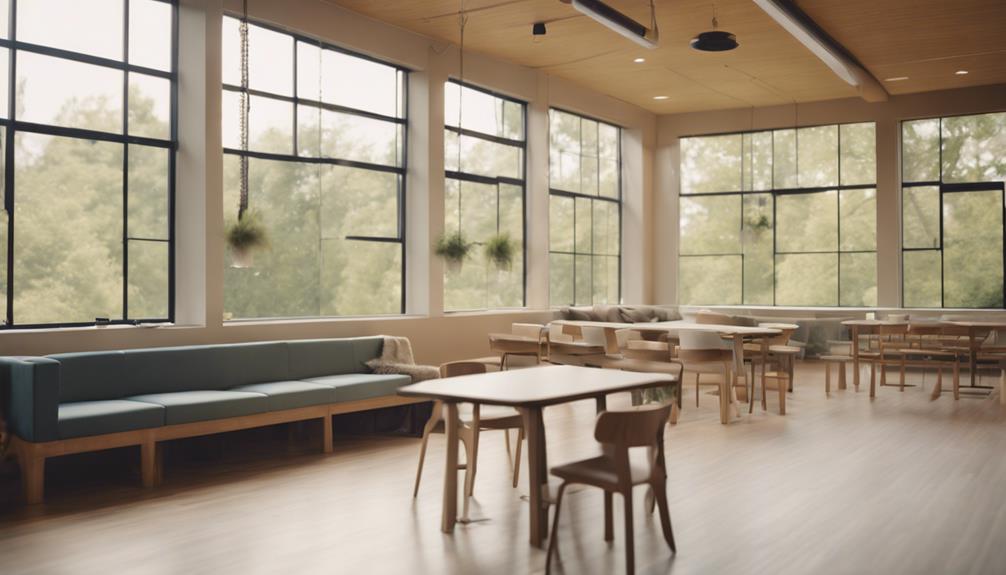
When designing versatile spaces, think about how each area can serve multiple purposes.
You’ll want to incorporate multi-purpose rooms, outdoor activity areas, and quiet reflection spaces that meet your guests’ diverse needs.
This flexibility not only enhances the retreat experience but also maximizes the use of your facility.
Multi-Purpose Room Design
Designing a multi-purpose room requires careful consideration of flexible layouts and features that can adapt to various activities and group sizes. You’ll want to create a space that supports yoga classes, group discussions, and workshops with ease. Here are three key elements to focus on:
- Flexible Seating Arrangements: Use movable furniture that can be quickly reconfigured based on the event type. This flexibility will create an inviting atmosphere for diverse activities.
- Movable Partitions: Incorporate movable partitions to divide the room into smaller areas, enabling simultaneous smaller group activities. This maximizes the room’s functionality and enhances participant engagement.
- Natural Lighting and Soundproofing: Prioritize large windows for natural lighting to foster a serene atmosphere. Combine this with acoustic panels to guarantee soundproofing, allowing for focused discussions and relaxation.
Don’t forget to include essential amenities like audio-visual equipment and adaptable lighting options.
Additionally, verify that your multi-purpose room features accessibility options, such as ramps and wide doorways, to comfortably welcome all participants.
With these considerations, you’ll create a versatile space that meets everyone’s needs.
Outdoor Activity Areas
Creating versatile outdoor activity areas enhances the retreat experience by accommodating a variety of activities, from yoga sessions to group workshops. You create a calming backdrop that promotes mindfulness and relaxation by designing flexible spaces that embrace natural elements like trees and water features.
Consider dividing your outdoor areas into distinct design zones for different activities. This layout guarantees clear pathways for movement and encourages spontaneous gatherings. Incorporating seating options such as benches, hammocks, and picnic spots fosters a sense of community among guests, enhancing their overall experience. Using sustainable materials in your construction aligns with the values of wellness retreat attendees, promoting environmental stewardship.
Here’s a table to help visualize the various activity zones:
Activity Type Design Zone Features Yoga Serene Garden Soft grass, shaded trees Workshops Open Meadow Benches, picnic tables Recreational Games Sports Field Flat terrain, versatile spaces
Quiet Reflection Spaces
Outdoor activity areas set the stage for vibrant interactions, while quiet reflection spaces offer a serene contrast, inviting guests to unwind and connect with their inner selves.
To create effective quiet reflection spaces, focus on these critical elements:
- Natural Elements: Use materials like wood and stone and incorporate large windows to enhance tranquility and foster a connection with nature.
- Versatile Seating: Provide a mix of cushions, benches, and hammocks to accommodate various activities—from solitary contemplation to small group interactions—ensuring everyone finds their comfort zone.
- Ambiance Enhancements: Integrate soft lighting, calming colors, and soothing scents to promote relaxation and enhance the overall experience for retreat participants.
Don’t forget soundproofing features to minimize external noise, allowing guests to immerse themselves fully in mindfulness practices.
By creating distinct zones for solitude and community, you’ll cater to the diverse needs of your guests.
Ultimately, these thoughtfully designed quiet reflection spaces will cultivate an atmosphere of tranquility, making it easier for participants to engage in introspection and rejuvenation during their retreat.
Incorporating Natural Elements

Incorporating natural elements into your retreat center can greatly enhance guest well-being by fostering a deeper connection to the environment. You can achieve this by maximizing natural light and views through large windows and open spaces, which studies show can increase guest satisfaction by up to 20%.
Integrating water features like ponds or fountains will create a calming atmosphere, as the sound of flowing water helps promote relaxation and lower stress levels.
Utilizing sustainable building materials, such as bamboo or reclaimed wood, aligns with eco-friendly practices and enhances your center’s aesthetic appeal. These materials support environmental consciousness and create a harmonious blend with nature.
Designing outdoor spaces, such as meditation gardens or walking trails, encourages interaction with nature, contributing to a holistic retreat experience. These features can enhance mindfulness practices and support personal growth, making your retreat center a sanctuary for transformation.
Planning Guest Accommodations
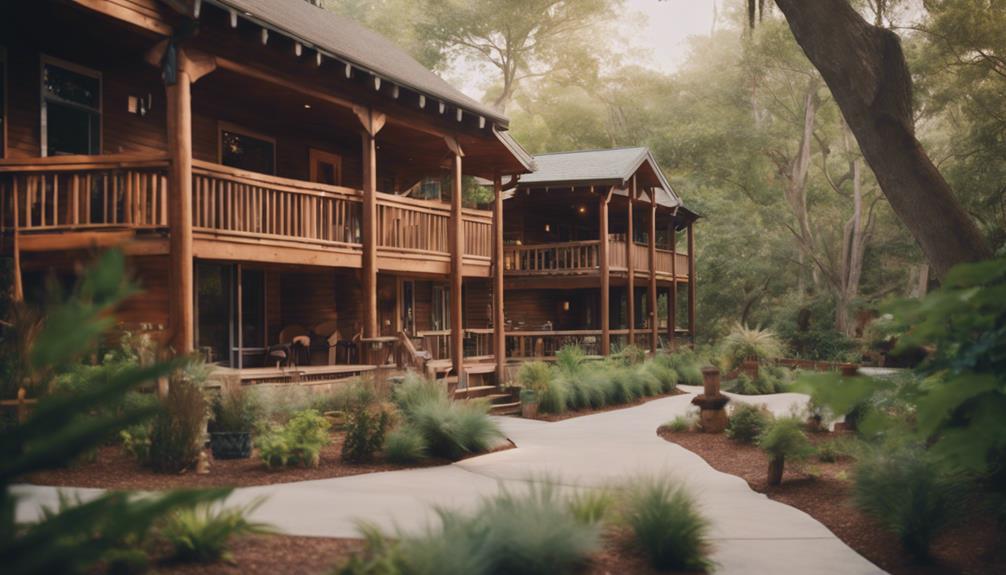
Designing comfortable and inviting guest accommodations is key to guaranteeing a memorable retreat experience that meets diverse needs and preferences. When planning guest accommodations, focus on creating a welcoming environment that enhances comfort and fosters community among guests.
Here are three essential aspects to reflect on:
- Diverse Lodging Options: Offer accommodations, such as eco-friendly cabins, glamping tents, or wellness suites. This variety can appeal to different tastes and promote inclusivity.
- Comfortable Bedding and Amenities: Confirm that each room has comfortable bedding, climate control, and access to natural light. These essential amenities significantly impact guest satisfaction and contribute to a positive retreat experience.
- Accessible Communal Spaces: Create shared areas like lounges or outdoor patios where guests can gather, socialize, and participate in group activities. These communal spaces not only enhance comfort but also encourage connections among participants.
Ensuring Health and Safety

Guaranteeing health and safety is vital for creating a secure and enjoyable retreat experience for all participants. Start by developing a thorough safety plan that outlines emergency protocols, evacuation routes, and contact information for local emergency services. This will help guarantee participant well-being during retreats.
Implement health measures like regular sanitation of communal spaces and accommodations, following CDC guidelines to minimize illness transmission. Make certain your retreat center complies with local health regulations by obtaining necessary permits and conducting exhaustive health and safety inspections before hosting any events.
Educating staff on health and safety measures is essential, as well as incorporating first aid training and emergency response procedures. This training will empower them to create a secure environment for all guests.
Don’t forget to continuously use participant feedback to refine your health and safety practices. By addressing guest concerns, you can foster a genuinely safe atmosphere.
Prioritizing these elements will enhance the overall experience and build trust among participants, guaranteeing they feel confident and cared for throughout their stay at your retreat center.
Marketing Your Retreat Center

To effectively market your retreat center, you need a robust online presence that attracts potential guests and showcases what you offer. A strong marketing strategy should focus on reaching your target audiences through various digital marketing channels. Here are three essential elements to take into account:
- SEO and Email Marketing: Optimize your website for search engines. An effective SEO strategy helps potential guests find your retreat. Complement this with email marketing, which boasts an average ROI of $42 for every dollar spent.
- Testimonials and Reviews: Leverage testimonials from past attendees. Since 90% of consumers read online reviews, showcasing positive experiences builds credibility and trust, influencing potential guests’ booking decisions.
- Influencer and Referral Programs: Collaborate with influencers in the wellness community to expand your visibility. Influencer marketing can generate up to 11 times the ROI of traditional advertising. Additionally, referral programs should be implemented to encourage previous participants to share their experiences, leading to higher conversion rates.
Frequently Asked Questions
How Do You Build a Retreat Center?
To build a retreat center, you’ll want to choose a serene location, design versatile spaces, incorporate sustainable practices, guarantee comfortable accommodations, and comply with local regulations. Each step is essential for a successful retreat experience.
How Do You Structure a Retreat?
Start by setting specific, simple objectives for your retreat. Structure a schedule that balances engaging activities with restful reflection time, while ensuring seamless logistics and thoughtful meals to maximize participant pleasure and overall satisfaction.
Is Owning a Retreat Center Profitable?
Yes, owning a retreat center can be profitable. With the wellness tourism market booming, you’ll attract diverse clients seeking personal growth, allowing you to capitalize on strong demand and potentially earn substantial annual revenue.
How Would You Design the Upcoming Retreat?
To design your upcoming retreat, you’ll define a unique theme, choose a serene location, create a balanced itinerary, incorporate essential facilities for comfort, and prioritize sustainability to guarantee participants an engaging, memorable experience.
Conclusion
As you begin the journey to create your retreat center, remember that it’s more than just a building; it’s a sanctuary for the soul.
By weaving together purpose, audience, and nature, you’ll craft a space where minds can unwind, and spirits can soar.
With thoughtful design and a sprinkle of creativity, your vision can bloom into a haven that invites all to pause, reflect, and rejuvenate.
Now, go forth and let your dreams take flight!
- About the Author
- Latest Posts
Introducing Ron, the home decor aficionado at ByRetreat, whose passion for creating beautiful and inviting spaces is at the heart of his work. With his deep knowledge of home decor and his innate sense of style, Ron brings a wealth of expertise and a keen eye for detail to the ByRetreat team.
Ron’s love for home decor goes beyond aesthetics; he understands that our surroundings play a significant role in our overall well-being and productivity. With this in mind, Ron is dedicated to transforming remote workspaces into havens of comfort, functionality, and beauty.
Spa Design
Ultimate Spa Room Design Plan Ideas
Open your mind to the transformative power of biophilic design in Ultimate Spa Room Design Plan Ideas…
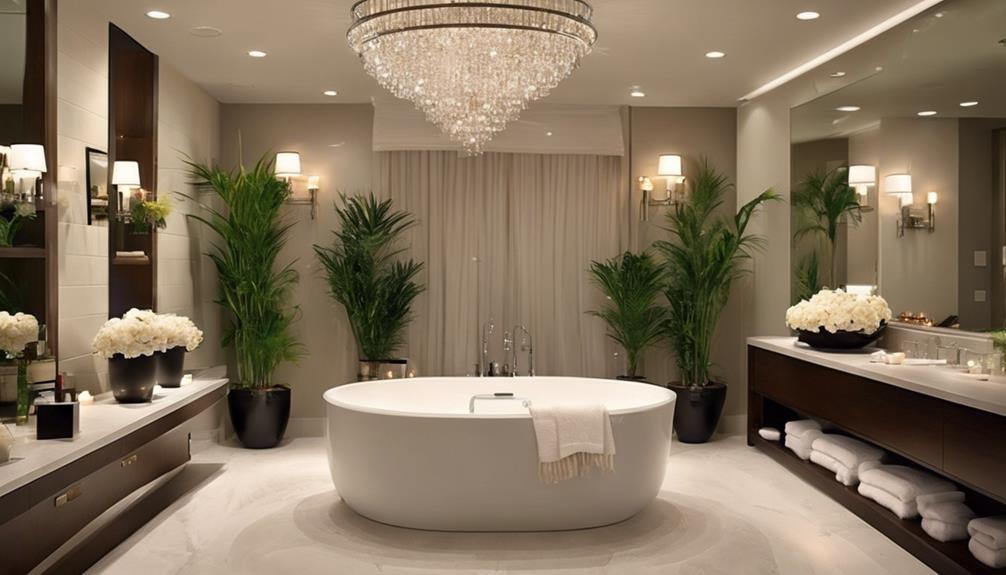
As we explore the realm of Ultimate Spa Room Design Plan Ideas, one aspect that might surprise you is the significance of incorporating biophilic design elements to enhance the overall ambiance.
By seamlessly blending nature-inspired elements into the spa room, we can create a harmonious space that promotes relaxation and tranquility.
This approach not only adds a touch of serenity but also elevates the sensory experience for guests, making it an essential consideration in crafting the ultimate spa retreat.
Key Takeaways
- Soft pastel shades and natural colors promote a calming atmosphere.
- Incorporate dimmable and natural lighting for serenity.
- Integrate natural elements like plants and water features.
- Choose functional furniture and enhance ambiance with tranquil sound and scents.
Relaxing Color Scheme Ideas
When selecting colors for a spa room to create a relaxing ambiance, soft pastel shades like pale blue, light pink, and mint green are excellent choices to instill a sense of calm and tranquility. These hues are perfect for spa interior design ideas as they evoke a serene atmosphere that promotes relaxation. Pairing these soft colors with soft lighting can enhance the peaceful ambiance, creating a soothing environment for guests to unwind and destress.
In addition to pastel shades, earthly tones such as warm browns, soft greens, and sandy hues can bring a grounding effect to the spa room. These natural colors connect with the tranquility of nature, providing a sense of balance and harmony. Integrating these earthly tones into the design scheme can further elevate the spa experience, enveloping visitors in a cocoon of serenity and comfort.
When considering spa interior design ideas, incorporating a mix of pastel colors and earthly tones can transform the space into a tranquil oasis, offering a retreat from the hustle and bustle of everyday life.
Lighting Strategies for Serenity

Soft, warm lighting techniques play a crucial role in creating a serene and calming atmosphere within spa rooms, enhancing the overall relaxation experience for guests. To achieve the perfect lighting design for your spa room, consider the following strategies:
- Dimmable Lights: Opt for dimmable lights to adjust the ambiance based on different treatments and client preferences.
- Natural Light Sources: Incorporate natural light sources like windows or skylights to amplify the feeling of tranquility and connection to the outdoors.
- LED Lighting: Choose energy-efficient LED lighting for its versatility in customizing color temperatures to match the desired mood.
- Layered Lighting: Implement a combination of task lighting, ambient lighting, and accent lighting to create a well-balanced and soothing environment that caters to various needs.
- Lighting Control Systems: Invest in lighting control systems to easily manage and set different lighting scenarios for different times of the day or specific treatments, enhancing the overall spa experience.
Incorporating Natural Elements
Incorporating natural elements into spa room design transforms the space into a tranquil oasis that rejuvenates the senses and promotes relaxation. To create a luxurious spa experience, consider integrating indoor plants, wood textures, and stone features into your spa decor. These elements bring a fresh and calming ambiance, connecting guests with nature. Organic materials like bamboo, rattan, and jute further enhance this natural connection, adding a touch of sophistication to your spa design.
Maximize the soothing effects by utilizing natural light through large windows or skylights, which infuse the spa room with a sense of openness and tranquility. Complementing these elements, earthy color palettes inspired by soft greens, blues, and earth tones contribute to a serene and relaxing atmosphere, perfect for unwinding in luxury.
For an added touch of rejuvenation, consider integrating water features such as indoor fountains or cascading water walls. These elements bring a sense of serenity, creating the ultimate spa environment for relaxation and renewal.
Functional and Stylish Furniture Choices

To ensure a harmonious blend of functionality and style in your spa room, selecting ergonomic and comfortable massage tables is paramount for client relaxation and therapist efficiency. When designing your massage room, treatment rooms, or reception areas, consider the following furniture choices:
- Ergonomic Massage Tables: Choose tables with adjustable height settings and plush cushioning for ultimate client comfort.
- Stylish Cabinetry: Opt for sleek cabinets with ample storage space for towels, linens, and essential oils, keeping everything organized and easily accessible.
- Versatile Seating Options: Incorporate cushioned chairs or stools that are both stylish and comfortable for clients during consultations or treatments.
- Adjustable Facial Beds: Invest in beds with adjustable positions and soft cushions to cater to a variety of treatments while ensuring client relaxation.
- Aesthetic Decor Pieces: Enhance the ambiance with quality decor items like elegant wall art, mirrors, and soothing lighting fixtures to create a tranquil atmosphere in your spa room.
Tranquil Sound and Scent Enhancements
Immersing clients in a sensory oasis, our spa room captivates with tranquil soundscapes and aromatic delights, fostering a serene ambiance for ultimate relaxation. At our day spa, we understand the impact that calming sounds and soothing scents can have on creating a truly rejuvenating experience.
By incorporating nature sounds, soft music, or the gentle trickle of water, we aim to transport our clients to a place of tranquility and peace. Essential oil diffusers with scents like lavender, eucalyptus, or chamomile further enhance the atmosphere, enveloping guests in a cocoon of relaxation.
To ensure an undisturbed experience, soundproofing the walls and ceilings minimizes outside noise, while a customizable sound system allows us to tailor the ambiance to individual preferences. By utilizing aromatherapy techniques and scented candles, we provide a multi-sensory journey that not only relaxes the body but also soothes the mind, creating a space that truly makes it look and feel like a sanctuary of serenity.
Frequently Asked Questions
How Do I Design My Spa Room?
We design our spa room by incorporating soft color palettes, natural elements like indoor plants, luxurious features, and a blend of old and new aesthetics. We ensure a soothing ambiance with dim lighting and unique design elements for character.
What Rooms Should Be in a Spa?
In a spa, essential rooms like reception, treatment, relaxation, and changing areas are vital. Additional facilities such as sauna, steam room, and hydrotherapy tubs enhance the experience. Specialized spaces like manicure stations and wellness rooms cater to diverse needs.
How to Build a Spa Room?
To build a spa room, we prioritize size, layout, ventilation, and lighting for comfort. We select calming colors, soft textures, and natural elements. Quality furniture, equipment, and decor enhance the experience. Privacy, soundproofing, and amenities elevate it.
How Can I Make My House Look Like a Spa?
To make our house look like a spa, we'll incorporate calming colors, natural elements, aromatherapy, luxurious textiles, dimmable lighting, soothing music, and comfortable seating. Our goal is to create a tranquil oasis where relaxation and rejuvenation are always at hand.
Conclusion
In conclusion, when it comes to creating the ultimate spa room design plan, it's all about finding the perfect balance between luxury and relaxation.
By incorporating soothing color schemes, strategic lighting, natural elements, stylish furniture, and calming sound and scent enhancements, you can create a space that truly transports your guests to a state of bliss.
Remember, the devil is in the details, so don't be afraid to get creative and add those special touches that make all the difference.
- About the Author
- Latest Posts
Introducing Ron, the home decor aficionado at ByRetreat, whose passion for creating beautiful and inviting spaces is at the heart of his work. With his deep knowledge of home decor and his innate sense of style, Ron brings a wealth of expertise and a keen eye for detail to the ByRetreat team.
Ron’s love for home decor goes beyond aesthetics; he understands that our surroundings play a significant role in our overall well-being and productivity. With this in mind, Ron is dedicated to transforming remote workspaces into havens of comfort, functionality, and beauty.
Retreat Ideas
Fun Ideas for a Creative Retreat
Embark on a journey of discovery, as we unveil an ocean of exciting and innovative activities for your creative retreat.

Embarking on a creative retreat is like setting sail on a voyage of self-discovery, where each wave carries the promise of new inspiration and uncharted creativity.
As we navigate through the vast sea of possibilities, our minds brimming with anticipation, we are met with a treasure trove of fun ideas waiting to be unearthed.
From the shores of collaborative brainstorming to the peaks of artistic challenges, there is a world of adventure and exploration awaiting us.
So, let's set our compass towards a horizon filled with exciting possibilities and see where this creative journey takes us.
Key Takeaways
- Outdoor workshops offer a dynamic space for artistic growth and inspiration.
- Collaborative group engagements ignite creativity, camaraderie, and skill enhancement.
- Mindfulness practices reduce stress, enhance focus, and promote relaxation for creativity.
- Adventure activities like hiking boost creativity, teamwork, and fresh perspectives for innovation.
Outdoor Workshops and Classes
Have you ever considered the invigorating experience of attending outdoor workshops and classes for a boost in creativity and mental well-being? Engaging in outdoor activities as a team during creative retreats can spark fresh ideas and enhance the overall experience. Creative retreats set in outdoor settings offer a unique opportunity to connect with nature, fostering inspiration and creativity among participants. The hands-on learning and exploration that outdoor workshops provide can lead to innovative approaches to artistic challenges.
Being surrounded by nature during these workshops creates a conducive environment for brainstorming and collaboration. The fresh air and natural light can invigorate the mind, allowing participants to immerse themselves fully in their creative processes. Whether it's painting landscapes, writing poetry by a river, or sculpting in a forest clearing, outdoor workshops offer a dynamic space for artistic growth.
Put simply, outdoor workshops and classes aren't only about learning new skills but also about embracing the beauty of the natural world to fuel our creative endeavors.
Artistic Group Activities and Challenges

Exploring the domain of artistic group activities and challenges, participants can engage in collaborative painting sessions and creative competitions to ignite their creativity and foster a sense of camaraderie. Team retreats can benefit greatly from these group art projects, where individuals work together towards a common artistic goal.
These activities not only encourage teamwork but also allow for the exchange of ideas and techniques, enhancing everyone's skills in the process. To add an extra layer of excitement, challenges like timed art competitions or themed art prompts can spark creativity and friendly competition among participants.
In addition, organizing a group art exhibition or showcase at the end of the retreat can provide a platform for individuals to display their work and celebrate their collective achievements. Engaging in art critique sessions during the retreat can also be incredibly beneficial, as participants receive constructive feedback to improve their artistic abilities.
Furthermore, hosting art workshops led by professional artists can offer valuable learning experiences and inspiration for all involved in the creative retreat.
Mindfulness and Meditation Sessions
During our creative retreat, participants will engage in rejuvenating mindfulness and meditation sessions aimed at enhancing focus, reducing stress, and tapping into our creative potential. Mindfulness and meditation practices are powerful tools that can help us cultivate a sense of calm and clarity, allowing for a deeper connection with our inner creative spark. By incorporating these sessions into our retreat schedule, we are providing attendees with the opportunity to center themselves, quiet the noise of everyday life, and fully immerse in the present moment.
| Benefits of Mindfulness and Meditation Sessions | |
|---|---|
| Reduces Stress | Increases Focus |
| Enhances Creativity | Promotes Relaxation |
Collaborative Brainstorming and Idea Sharing

As we move from our rejuvenating mindfulness and meditation sessions, we shift our focus towards collaborative brainstorming and idea sharing, fostering a dynamic environment where creativity can flourish through shared insights and collective innovation. Here are four crucial aspects of this collaborative process:
- Building on Creativity: Collaborative brainstorming allows participants to share their unique ideas and perspectives, creating a melting pot of creativity that can lead to novel solutions and concepts.
- Supportive Environment: Idea sharing cultivates a supportive atmosphere where individuals feel safe expressing their thoughts, leading to a rich exchange of ideas and feedback that can spark new creative directions.
- Diverse Perspectives: Group discussions enable the generation of diverse viewpoints, which can help in exploring different angles and approaches to challenges, fostering a culture of innovation and out-of-the-box thinking.
- Inspiration and Breakthroughs: Sharing experiences and insights can serve as a catalyst for inspiration, igniting new creative breakthroughs and pushing participants to explore innovative pathways in their thinking process.
Collaborative brainstorming and idea sharing not only enhance creativity but also strengthen bonds among participants, making it a crucial component of any creative retreat experience.
Adventure and Exploration Excursions
Embarking on thrilling adventure and exploration excursions, we immerse ourselves in nature's wonders and push the boundaries of our comfort zones. These excursions, which can involve activities like hiking, kayaking, or zip-lining, offer a unique opportunity for team members to connect with nature and each other.
Engaging in outdoor adventures not only boosts creativity and inspires new ideas but also fosters communication skills and promotes teamwork. By exploring unfamiliar landscapes and trying new experiences together, we can spark innovation and gain fresh perspectives that are invaluable in a creative retreat setting.
These adventures create memorable moments and bonding opportunities among participants, strengthening the relationships within the group. When planning to create a retreat that encourages collaboration and creativity, incorporating adventure and exploration excursions can be a powerful way to energize and inspire team members while fostering a sense of unity and shared accomplishment.
Frequently Asked Questions
How Do You Make a Retreat Interesting?
To make a retreat interesting, we blend diverse activities, workshops, and classes to cater to varied interests and skill levels. We foster a relaxed, inspiring environment that encourages exploration and collaboration, promoting personal growth and self-expression.
How to Do a Creative Retreat?
To do a creative retreat, we'll gather in a serene spot, craft a diverse agenda, lead engaging workshops, encourage self-reflection, and nurture a supportive atmosphere. Let's spark creativity, explore, and connect deeply.
What Are Fun Activities for Board Retreats?
For board retreats, we recommend team-building exercises, creative workshops like painting or DIY crafts, brainstorming sessions, outdoor activities like nature walks or bonfires, and relaxation sessions such as yoga or spa treatments for a well-rounded experience.
What Is the Best Game for a Group Retreat?
When it comes to the best game for a group retreat, we highly recommend escape room challenges. They foster teamwork, critical thinking, and excitement, creating a dynamic experience that brings people together.
Conclusion
To sum up, hosting a creative retreat can lead to personal growth and relaxation, while fostering a supportive community of like-minded individuals.
Did you know that 90% of participants in creative retreats reported feeling more inspired and motivated after attending?
By offering diverse workshops and activities, ensuring participant safety, and collecting feedback for future improvements, a successful creative retreat can provide an invigorating and inspiring experience for all involved.
- About the Author
- Latest Posts
Introducing Ron, the home decor aficionado at ByRetreat, whose passion for creating beautiful and inviting spaces is at the heart of his work. With his deep knowledge of home decor and his innate sense of style, Ron brings a wealth of expertise and a keen eye for detail to the ByRetreat team.
Ron’s love for home decor goes beyond aesthetics; he understands that our surroundings play a significant role in our overall well-being and productivity. With this in mind, Ron is dedicated to transforming remote workspaces into havens of comfort, functionality, and beauty.
Spa Design
10 Dental Design Spa Trends in San Diego
Immerse yourself in the innovative world of dental design spa trends in San Diego, where cutting-edge concepts are reshaping the future of dentistry.
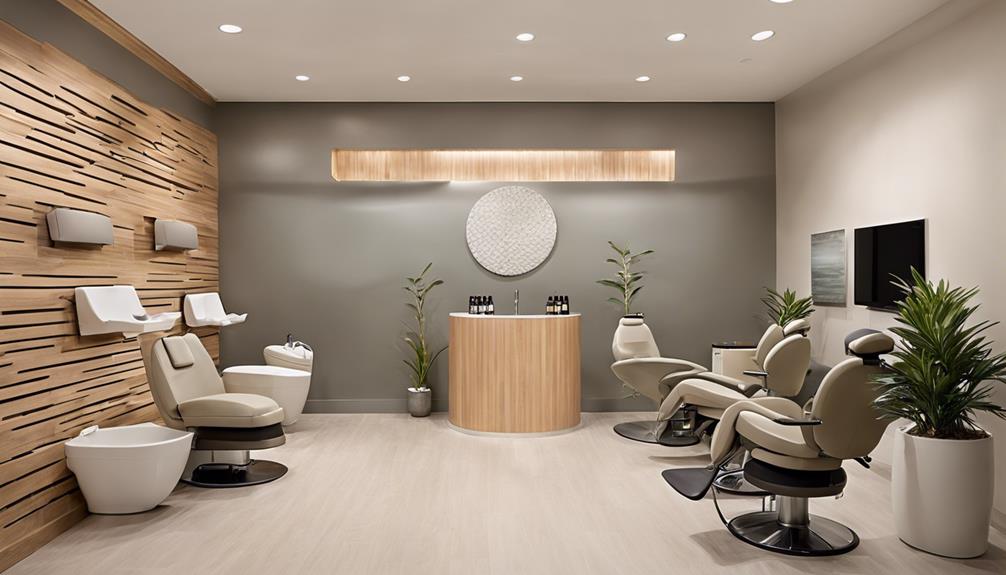
As we explore the evolving landscape of dental design spa trends in San Diego, one might question the necessity of incorporating innovative elements into traditional dental practices.
However, the fusion of sustainability, technology, and patient-centric design in these spa trends offers a glimpse into the future of dentistry.
The integration of sustainable materials, biophilic elements, and multi-sensory experiences not only revolutionizes the patient experience but also sets a new standard for dental care.
Stay tuned to discover how these trends are reshaping the dental industry and enhancing the overall well-being of patients in San Diego's dental spas.
Key Takeaways
- Sustainable materials like bamboo and reclaimed wood are prevalent in San Diego dental spas.
- Biophilic design elements such as natural light and greenery enhance patient well-being.
- Technology integration in treatment rooms includes smart dental equipment and virtual reality for improved care.
- Multi-sensory relaxation experiences like aromatherapy and calming visuals promote patient comfort.
Sustainable Materials in Design
Incorporating sustainable materials into dental spa design elevates both the aesthetic appeal and environmental consciousness of San Diego's dental industry.
In San Diego, dental spas are embracing eco-friendly practices by utilizing materials like bamboo, reclaimed wood, and recycled metal. These sustainable choices not only enhance the visual appeal of the spa but also demonstrate a commitment to environmental responsibility.
By opting for these eco-conscious materials, dental spa owners in San Diego are contributing to a greener environment and setting a positive example for the industry as a whole. Additionally, incorporating energy-efficient lighting and water-saving fixtures further promotes sustainability within these spaces.
This focus on sustainable materials not only adds a touch of sophistication to the design but also aligns with the values of ecological consciousness that are becoming increasingly important in the dental industry.
San Diego's dental spas are leading the way in combining style with eco-friendly practices, setting a new standard for innovative and environmentally conscious design.
Biophilic Design Elements
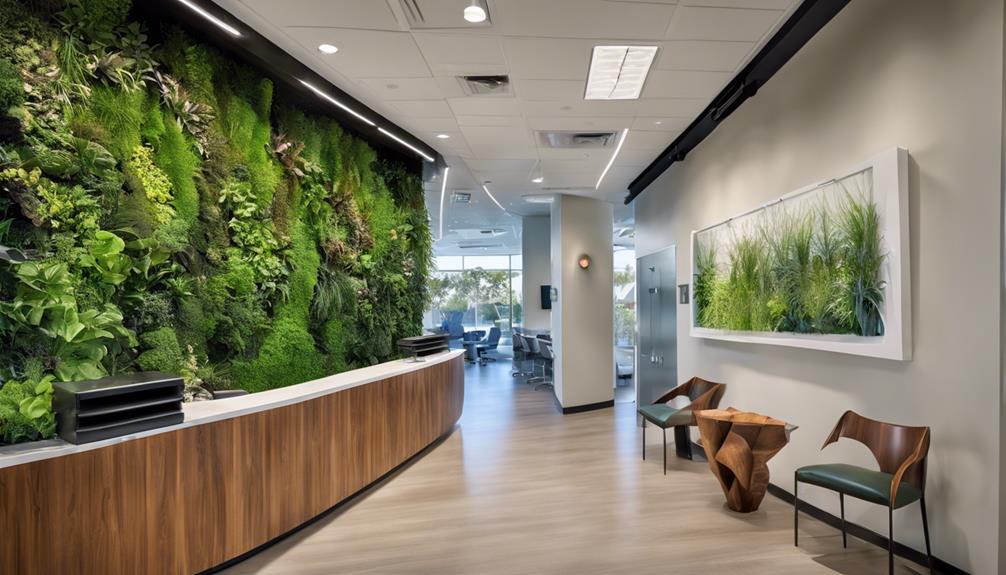
When it comes to creating a calming and stress-free environment in dental spa settings, natural light benefits and plant-filled spaces play a crucial role. Incorporating these biophilic design elements not only enhances patient comfort but also promotes relaxation.
Natural Light Benefits
Natural light, with its proven benefits for mood and well-being, plays a pivotal role in enhancing the dental spa experience in San Diego. In Dental Design SD, incorporating natural light not only improves the patient experience but also boosts productivity and reduces stress and anxiety.
Biophilic design principles emphasize the importance of connecting with nature, and natural light promotes this connection by creating a sense of well-being. Additionally, exposure to daylight in dental spaces helps regulate circadian rhythms, contributing to the overall health of both patients and staff.
Plant-Filled Spaces
Enhancing the ambiance of dental spas in San Diego, the integration of plant-filled spaces brings a sense of tranquility and connection to nature, benefiting both patients and staff alike. Biophilic design elements are on the rise, with dental spaces incorporating greenery to promote patient well-being and create a calming atmosphere.
The presence of plants not only reduces stress levels but also enhances air quality, contributing to a more relaxing environment for all. By embracing biophilic design, dental spas in San Diego are fostering a connection to nature that positively impacts the overall satisfaction and experience of patients.
This trend towards plant-filled spaces aligns with the goal of creating healing and rejuvenating environments for individuals seeking dental care.
- Greenery enhances patient well-being
- Plants contribute to a calming atmosphere
- Biophilic design promotes a connection to nature
Technology-Integrated Treatment Rooms
We're stepping into a new era of dental care that harmoniously blends cutting-edge technology with patient comfort.
Smart dental equipment, digital patient records, and virtual reality relaxation are revolutionizing the treatment experience in San Diego dental spas.
These technology-integrated treatment rooms are shaping a future where personalized care and state-of-the-art tools converge to elevate patient outcomes and satisfaction.
Smart Dental Equipment
Integrating cutting-edge technology into dental treatment rooms in San Diego enhances patient care and streamlines procedures for optimal efficiency. Smart dental equipment is revolutionizing the way dental practices operate. Here are a few key features that make this technology stand out:
- Advanced tools like digital imaging systems and chairside monitors improve diagnostics.
- Real-time data analysis allows for precise treatment planning.
- Streamlined workflows enhance the overall patient experience.
These innovations not only elevate the quality of care but also modernize dental practices, reflecting San Diego's commitment to staying at the forefront of technological advancements in dentistry.
Digital Patient Records
In San Diego's cutting-edge dental spas, digital patient records seamlessly integrate into treatment rooms, revolutionizing the way dentists access and manage vital information for enhanced patient care. This advanced technology allows for instant access to patient records, facilitating efficient and accurate treatment.
San Diego dental spas leverage technology-integrated treatment rooms to track treatment progress, create personalized care plans, and offer comprehensive dental services. By integrating digital patient records into treatment rooms, communication among dental team members is enhanced, leading to coordinated and tailored care for each patient.
The use of technology in San Diego dental spas ensures a seamless patient experience by digitizing records for quick reference and updates, ultimately improving the quality of care provided to patients.
Virtual Reality Relaxation
Enhancing the patient experience in San Diego's cutting-edge dental spas, Virtual Reality relaxation in technology-integrated treatment rooms offers immersive environments to alleviate anxiety and promote comfort during dental procedures. Patients can escape to calming settings such as a beach or forest through VR technology, transforming their experience.
The immersive experiences provided by VR integration help distract patients from discomfort, leading to a more positive and relaxed visit. Studies have shown that these distraction techniques significantly reduce perceived pain levels and anxiety during dental treatments.
This growing trend of Virtual Reality relaxation in dental settings aims to enhance overall patient satisfaction by prioritizing patient comfort and well-being.
- Virtual Reality relaxation offers immersive environments
- Patients can choose calming settings like a beach or forest
- Studies show reduced pain levels and anxiety
Multi-Sensory Relaxation Experiences

Utilizing a blend of aromatherapy, soothing music, and calming visuals, we craft a multi-sensory oasis at our dental spa in San Diego to envelop patients in tranquility and relaxation. In our space, specialized lighting techniques, such as chromotherapy, are strategically employed to enhance the overall relaxation experience and promote a profound sense of well-being. To add a tactile dimension to this soothing environment, we incorporate elements like heated massage chairs, warm towels, and essential oils, further immersing patients in a world of comfort and serenity. Water features like fountains or aquariums are seamlessly integrated into our dental spa design, creating a calming ambiance that helps patients unwind. Moreover, we offer high-tech relaxation tools like virtual reality headsets and noise-canceling headphones to elevate the multi-sensory experience, ensuring each visit is a harmonious blend of innovation and relaxation.
| Aromatherapy | Specialized Lighting | High-tech Tools |
|---|---|---|
| Essential oils | Chromotherapy | Virtual reality headsets |
| Calming scents | Ambient light fixtures | Noise-canceling headphones |
| Relaxing fragrances | LED mood lighting | Audio relaxation apps |
Customized Patient Comfort Amenities
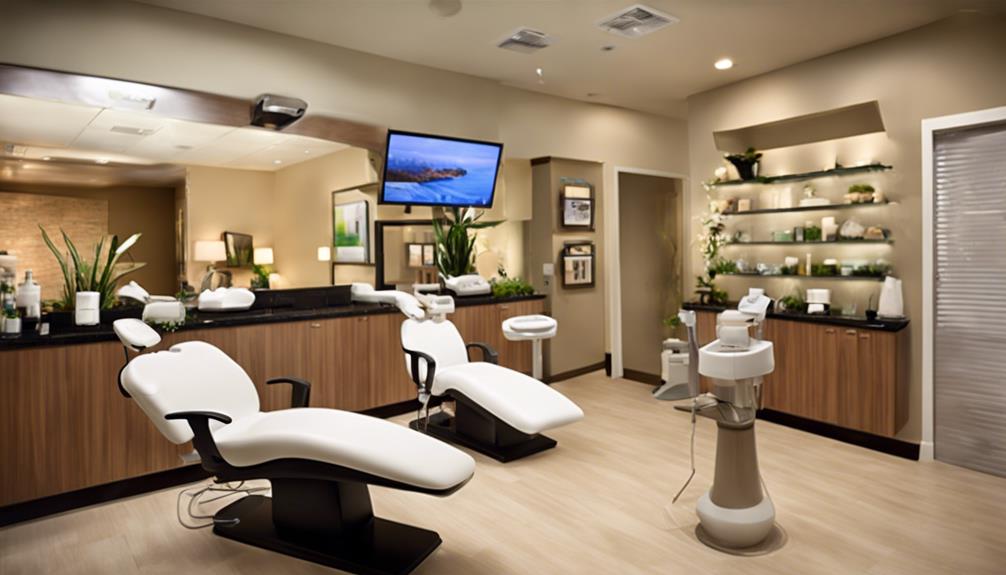
Crafting a personalized oasis of comfort and relaxation, our dental spa in San Diego meticulously tailors patient comfort amenities to elevate the overall experience. At our facility, we prioritize personalized patient comfort amenities to ensure a soothing environment for every individual. Here are three key features that set our customized treatment rooms apart:
- Warm Towels: Offering warm towels to our patients adds a luxurious touch, promoting relaxation and comfort during their visit.
- Adjustable Lighting: Our customized treatment rooms feature adjustable lighting options, allowing patients to set the ambiance to their preference for a calming experience.
- Ergonomic Treatment Chairs: We prioritize optimal comfort by providing ergonomic treatment chairs and cozy blankets to enhance the overall dental spa experience.
Wellness Programs for Oral Health

We prioritize preventive care and a holistic treatment approach in our oral health wellness programs.
By focusing on education, regular check-ups, and healthy habits, we aim to reduce dental issues and enhance individuals' quality of life.
Our programs also integrate nutritional guidance, stress management techniques, and personalized treatment plans for long-term oral health benefits.
Preventive Care Programs
In dental spas, preventive care programs prioritize promoting optimal oral health through tailored wellness plans that focus on regular check-ups, cleanings, and screenings. These programs are designed to prevent dental issues by emphasizing early detection and intervention.
Key components of these programs include:
- Personalized care plans to address individual oral health needs
- Regular check-ups to monitor oral health status
- Early detection of dental problems to prevent complications
Holistic Treatment Approach
Utilizing a comprehensive approach that merges dental treatments with holistic practices, dental design spas in San Diego implement wellness programs that prioritize both oral health and overall well-being. These wellness programs go beyond traditional dental care by integrating holistic approaches like nutrition counseling and stress management. By addressing lifestyle factors such as diet, exercise, and mental wellness, these programs promote preventive care and empower patients to take charge of their oral health.
The holistic treatment approach emphasizes the interconnectedness of oral health with overall wellness, encouraging a balanced and healthy lifestyle. Through education and personalized care, dental design spas aim to provide patients with the tools to maintain optimal oral health beyond just routine dental procedures.
Artistic Murals and Visual Installations

Enhancing the dental spa ambiance in San Diego, artistic murals and visual installations are becoming increasingly popular for creating a serene and visually captivating environment for patients. Local artists are often sought after to infuse their creativity into these spaces, adding a personal and unique touch to the design.
Here are three reasons why artistic elements play a crucial role in modern dental spa trends:
- Customized Artwork: Local artists are commissioned to create bespoke pieces that align with the practice's values and aesthetics, ensuring a cohesive and harmonious visual experience.
- Relaxing Environment: Artistic murals and installations help patients relax and feel at ease during their dental treatments, transforming the clinical setting into a calming sanctuary.
- Elegant Creativity: Creative visuals not only elevate the overall ambiance of the dental spa but also add a sense of sophistication and innovation to the space, setting it apart as a beacon of creativity in San Diego's dental scene.
Virtual Reality Dental Experiences

Virtual reality technology revolutionizes the patient experience at dental design spas by offering immersive consultations and treatment previews.
Through virtual reality technology, patients can step into a digital world where they visualize their dental procedures in intricate detail. This immersive experience not only enhances their understanding of the treatment process but also boosts their comfort levels.
Moreover, virtual reality plays a crucial role in treatment planning by providing a realistic view of the expected outcomes before the actual procedures commence. Patients can explore different treatment options, make informed decisions about their dental care, and actively participate in the planning process.
Green Practices and Environmental Consciousness

Embracing sustainable practices, our San Diego dental spas are actively incorporating eco-friendly materials and energy-efficient solutions to promote environmental awareness and responsibility. In our commitment to green practices and environmental consciousness, we've focused on the following key initiatives:
- Utilization of eco-friendly materials: From furniture to flooring, we prioritize the use of sustainable and recyclable materials in our dental spa designs.
- Integration of energy-efficient lighting: Energy-efficient LED lighting not only helps in reducing our carbon footprint but also creates a soothing ambiance for our patients.
- Water conservation efforts: By implementing water-saving technologies and low-flow fixtures, we strive to minimize water wastage without compromising on the quality of care provided.
These efforts not only reflect our dedication to environmental stewardship but also enhance the overall experience for our patients, who increasingly seek eco-conscious options in their healthcare choices.
Collaborative Spaces for Integrated Care

How do collaborative spaces in dental design spas revolutionize integrated care for patients in San Diego?
In San Diego collaborative spaces, dental professionals come together to provide integrated care that prioritizes a patient-centered approach. By housing various specialists in one location, these spaces enable seamless communication and teamwork among providers, resulting in comprehensive treatment plans tailored to individual patient needs.
This integration of services, including dental, orthodontic, cosmetic, and wellness care, ensures a holistic approach to oral health and overall well-being. Patients benefit from the convenience and efficiency of receiving all-encompassing care under one roof, with the added assurance of coordinated services within the collaborative space.
The collaborative nature of these dental design spas not only enhances the quality of care but also fosters a sense of trust and confidence in the healthcare delivery process. Integrated care in San Diego collaborative spaces represents a progressive model that prioritizes the well-being and satisfaction of patients.
Frequently Asked Questions
What Is the Market Size for Dental Aesthetics?
We estimate the global dental aesthetics market to reach $6.9 billion by 2024, with the U.S. cosmetic dentistry market projected to surpass $32 billion by 2025. San Diego's industry growth is fueled by demand for cosmetic dental services and technological advances.
What Is the Aesthetic Side of Dentistry?
The aesthetic side of dentistry goes beyond traditional dental care, focusing on enhancing smiles through cosmetic procedures. Are you ready to transform your smile with treatments like whitening, veneers, bonding, and contouring?
Conclusion
In conclusion, the dental design spa trends in San Diego are revolutionizing the way patients experience oral care.
From sustainable materials to virtual reality dental experiences, the future of dentistry is here.
With cutting-edge technology, personalized amenities, and a focus on patient comfort, San Diego's dental spas are taking oral health to the next level.
It's like stepping into a dental oasis where every smile is transformed into a work of art.
- About the Author
- Latest Posts
Introducing Ron, the home decor aficionado at ByRetreat, whose passion for creating beautiful and inviting spaces is at the heart of his work. With his deep knowledge of home decor and his innate sense of style, Ron brings a wealth of expertise and a keen eye for detail to the ByRetreat team.
Ron’s love for home decor goes beyond aesthetics; he understands that our surroundings play a significant role in our overall well-being and productivity. With this in mind, Ron is dedicated to transforming remote workspaces into havens of comfort, functionality, and beauty.
-
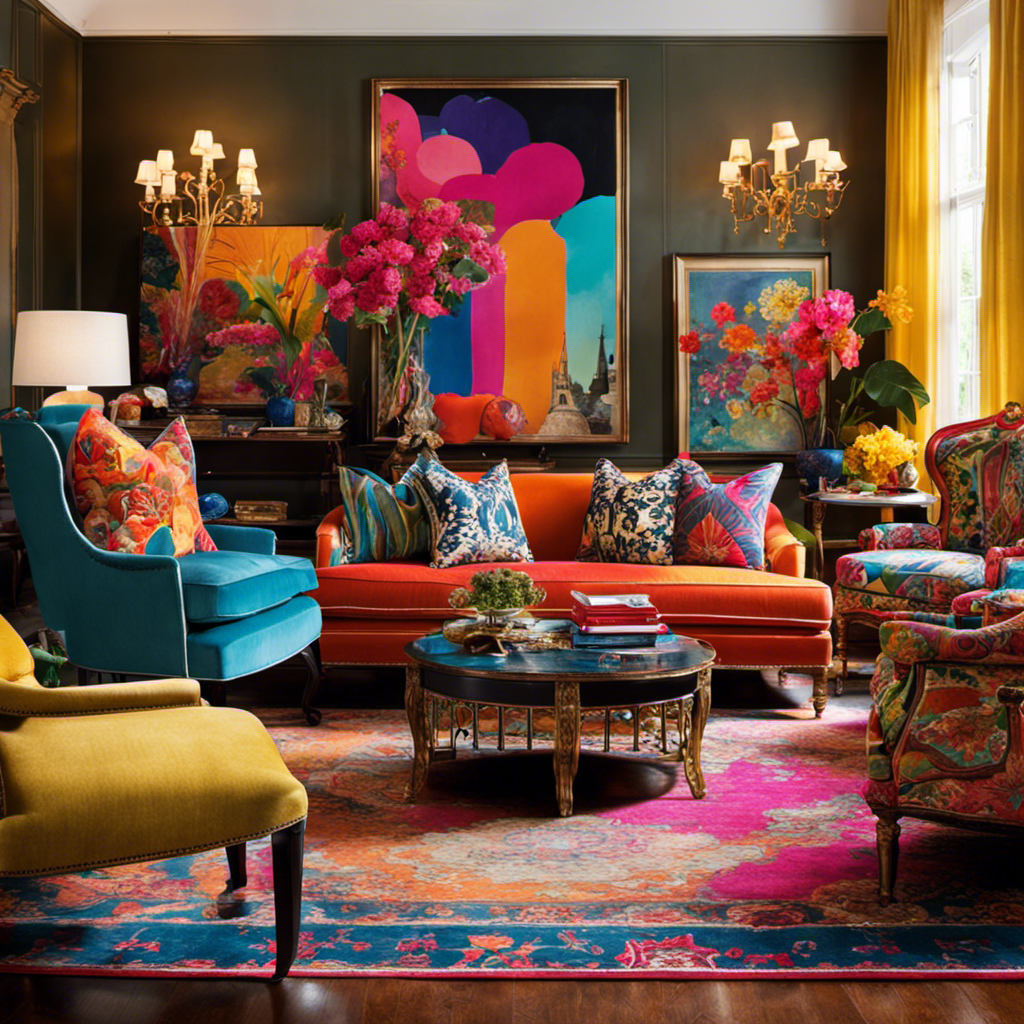
 Decor4 days ago
Decor4 days agoMaximalist Decor Explained: Embrace More Style
-

 Vetted4 weeks ago
Vetted4 weeks ago15 Best Drip Irrigation Systems to Keep Your Garden Thriving
-

 Vetted1 week ago
Vetted1 week ago15 Best Foot Massagers for Neuropathy to Soothe Your Feet and Relieve Discomfort
-

 Vetted2 weeks ago
Vetted2 weeks ago15 Best Sports Laundry Detergents for Keeping Your Activewear Fresh and Clean
-

 Vetted2 weeks ago
Vetted2 weeks ago15 Best Tall Toilets for Seniors That Combine Comfort and Safety
-

 Vetted3 weeks ago
Vetted3 weeks ago15 Best Dish Scrubbers to Keep Your Kitchen Sparkling Clean
-

 Decor3 weeks ago
Decor3 weeks agoWhat Is Eclectic Home Decor
-

 Vetted1 day ago
Vetted1 day ago15 Best Organic Pest Control Solutions for a Naturally Pest-Free Home

























